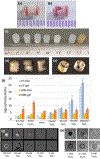Design Considerations to Facilitate Clinical Radiological Evaluation of Implantable Biomedical Structures
- PMID: 33449622
- PMCID: PMC8670580
- DOI: 10.1021/acsbiomaterials.0c01439
Design Considerations to Facilitate Clinical Radiological Evaluation of Implantable Biomedical Structures
Abstract
Clinical effectiveness of implantable medical devices would be improved with in situ monitoring to ensure device positioning, determine subsequent damage, measure biodegradation, and follow healing. While standard clinical imaging protocols are appropriate for diagnosing disease and injury, these protocols have not been vetted for imaging devices. This study investigated how radiologists use clinical imaging to detect the location and integrity of implanted devices and whether embedding nanoparticle contrast agents into devices can improve assessment. To mimic the variety of devices available, phantoms from hydrophobic polymer films and hydrophilic gels were constructed, with and without computed tomography (CT)-visible TaOx and magnetic resonance imaging (MRI)-visible Fe3O4 nanoparticles. Some phantoms were purposely damaged by nick or transection. Phantoms were implanted in vitro into tissue and imaged with clinical CT, MRI, and ultrasound. In a blinded study, radiologists independently evaluated whether phantoms were present, assessed the type, and diagnosed whether phantoms were damaged or intact. Radiologists identified the location of phantoms 80% of the time. However, without incorporated nanoparticles, radiologists correctly assessed damage in only 54% of cases. With an incorporated imaging agent, the percentage jumped to 86%. The imaging technique which was most useful to radiologists varied with the properties of phantoms. With benefits and drawbacks to all three imaging modalities, future implanted devices should be engineered for visibility in the modality which best fits the treated tissue, the implanted device's physical location, and the type of required information. Imaging protocols should also be tailored to best exploit the properties of the imaging agents.
Keywords: clinical imaging; contrast agent; implantable device; nanoparticles.
Figures




Similar articles
-
Incorporating Tantalum Oxide Nanoparticles into Implantable Polymeric Biomedical Devices for Radiological Monitoring.Adv Healthc Mater. 2023 Jul;12(18):e2203167. doi: 10.1002/adhm.202203167. Epub 2023 Mar 13. Adv Healthc Mater. 2023. PMID: 36848875 Free PMC article.
-
Multimodal Breast Phantoms for Microwave, Ultrasound, Mammography, Magnetic Resonance and Computed Tomography Imaging.Sensors (Basel). 2020 Apr 23;20(8):2400. doi: 10.3390/s20082400. Sensors (Basel). 2020. PMID: 32340281 Free PMC article.
-
Incorporating Radiopacity into Implantable Polymeric Biomedical Devices for Clinical Radiological Monitoring.bioRxiv [Preprint]. 2023 Jan 8:2023.01.06.523025. doi: 10.1101/2023.01.06.523025. bioRxiv. 2023. Update in: Adv Healthc Mater. 2023 Jul;12(18):e2203167. doi: 10.1002/adhm.202203167. PMID: 36711467 Free PMC article. Updated. Preprint.
-
Computed tomographic and magnetic resonance features of gynecologic abnormalities in women presenting with acute or chronic abdominal pain.Ultrasound Q. 2007 Sep;23(3):167-75. doi: 10.1097/RUQ.0b013e31815202df. Ultrasound Q. 2007. PMID: 17805165 Review.
-
Advances in digital and physical anthropomorphic breast phantoms for x-ray imaging.Med Phys. 2018 Oct;45(10):e870-e885. doi: 10.1002/mp.13110. Epub 2018 Aug 28. Med Phys. 2018. PMID: 30058117 Review.
Cited by
-
Radiopaque Implantable Biomaterials for Nerve Repair.bioRxiv [Preprint]. 2023 Jan 6:2023.01.05.522860. doi: 10.1101/2023.01.05.522860. bioRxiv. 2023. Update in: Nanomedicine. 2023 Aug;52:102692. doi: 10.1016/j.nano.2023.102692. PMID: 36711915 Free PMC article. Updated. Preprint.
-
Computed tomography technologies to measure key structural features of polymeric biomedical implants from bench to bedside.J Biomed Mater Res A. 2024 Nov;112(11):1893-1901. doi: 10.1002/jbm.a.37735. Epub 2024 May 10. J Biomed Mater Res A. 2024. PMID: 38728118
-
Device Design and Advanced Computed Tomography of 3D Printed Radiopaque Composite Scaffolds and Meniscus.Adv Funct Mater. 2024 Oct 29;34(44):2404860. doi: 10.1002/adfm.202404860. Epub 2024 May 17. Adv Funct Mater. 2024. PMID: 39619322
-
In vivo Biomedical Imaging of Immune Tolerant, Radiopaque Nanoparticle-Embedded Polymeric Device Degradation.bioRxiv [Preprint]. 2023 Oct 30:2023.10.26.564238. doi: 10.1101/2023.10.26.564238. bioRxiv. 2023. Update in: Acta Biomater. 2024 Jun;181:222-234. doi: 10.1016/j.actbio.2024.04.031. PMID: 37961412 Free PMC article. Updated. Preprint.
-
Methacrylate-Modified Gold Nanoparticles Enable Non-Invasive Monitoring of Photocrosslinked Hydrogel Scaffolds.Adv Nanobiomed Res. 2022 Jul;2(7):2200022. doi: 10.1002/anbr.202200022. Epub 2022 Jun 15. Adv Nanobiomed Res. 2022. PMID: 36177378 Free PMC article.
References
-
- Pawelec KM; Wardale RJ; Best SM; Cameron R The effects of scaffold architecture and fibrin gel addition on tendon cell phenotype. J. Mater. Sci. Mater. Med 2015, 26, 5349, DOI: 0.1007/s10856-014-5349-3. - PubMed
-
- Simons MP; Smietanski M; Bonjer HJ; Bittner R; Miserez M; Aufenacker TJ; Fitzgibbons RJ; Chowbey PK; Tran HM; Sani R; Berrevoet F; Bingener J; Bisgaard T; Bury K; Campanelli G; Chen DC; Conze J; Cuccurullo D; de Beaux AC; Eker HH; Fortelny RH; Gillion JF; van den Heuvel BJ; Hope WW; Jorgensen LN; Klinge U; Koeckerling F; Kukleta JF; Konate Il; Liem AL; Lomanto D; Loos MJA; Lopez-Cano M; Misra MC; Montgomery A; Morales-Conde S; Muysoms FE; Neibuhr H; Nordin P; Pawlak M; van Ramshorst GH; Reinpold WMJ; Sanders DL; Schouten N; Smedberg S; Simmermacher RKJ; Tumtavitikul S; van Veenendaal N; Weyhe D; Wijsmuller AR International guidelines for groin hernia management. Hernia 2018, 2(1), 1–165, DOI: 10.1007/s10029-017-1668-x. - DOI - PMC - PubMed
Publication types
MeSH terms
Grants and funding
LinkOut - more resources
Full Text Sources
Other Literature Sources
Medical
